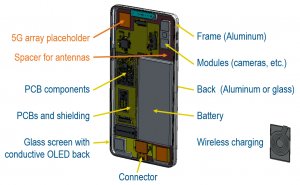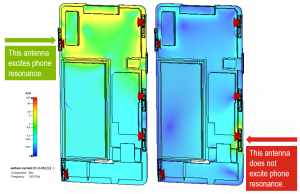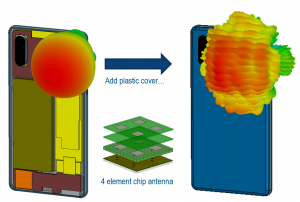For more in-depth information and expert advice, please visit the SIMULIA Community for a variety of resources about 5G, antennas, phone design and more. This particular post on the SIMULIA Community is a great place to start.
Looking for everything CST Studio Suite? Start here.
Looking for everything Antenna Magus? Start here.
Also check out our, 5G mm-Wave Compatible Phone Cover Design paper on our website.
5G is upon us. The promise of higher speed for high data rate communication and lower latency for real-time interaction is alluring for users. This combination will not only provide for new video formats like 360 degree video (video traffic is expected to account for 73% of all mobile data traffic by 2023), but also enable new technologies such as autonomous driving, augmented or virtual reality interaction, and a tactile internet with applications in fields ranging from industry automation and transport systems to healthcare, education and gaming.
Antenna design for mobile phones has always been a challenging topic for engineers, and designing antennas to support the new 5G frequency bands will raise the bar further. Two frequency ranges are of most interest: frequency range 1 for sub 6 GHz bands communication and frequency range 2 for communication at the millimeter (mm) wave frequencies above 24 GHz. Some of the bands are still under discussion, and the exact frequency designations will vary geographically. Initial phone integration has focused on sub 6 GHz antennas, and millions of subscribers around the world already have 5G mobile phone contracts. mm-Wave support has initially been used for providing broadband links to homes or other fixed infrastructure, but is gradually finding its way into mobile phones too.
Design Challenges
Simulation plays a fundamental role in designing antennas in general, and especially for designing the highly customized, individually tailored, antennas found in compact mobile devices. The challenges in the two frequency ranges are different, though.
Sub 6 GHz Antennas
Sub 6 GHz antennas have to be designed in the context of the compact mobile phone, fitting in to whatever space is available among all the other components which are densely packed into the form factor specified by the design team. Of course it is not only 5G capable antennas that are required. 5G will be used alongside existing 4G, 3G and Wi-Fi communication channels. This increases the number of antennas to be integrated in the phone, especially since most of these standards also include support for Massive Input Massive Output (MIMO) multi-antenna operation. Even if individual elements can cater for different standards simultaneously, there will still be a requirement for housing at least half a dozen antennas.

The antennas don’t only function as standalone “antennas” in the traditional sense, but there is a strong interaction with the rest of phone. Understanding the resonant behavior of the phone is important since the antenna to couple energy into natural phone resonances. These are strongly dependent on the exact configuration of the internal structure, which can change over design cycles. It is thus crucial to design the antenna in the context of the full phone, with materials, components and connections between them modelled with sufficient fidelity.

Optimal placement of the antennas in the phone, and also relative to each other, is critical to their performance. Positioning changes of a few millimeters will make the difference between a well and poorly performing system. Antenna engineers must be able to respond quickly to design changes. Immediate access to design change descriptions, an efficient workflow for simulation model setup, and of course efficient simulation algorithms, are all extremely important if good antenna designs are to be achieved within the tight time constraints of a short device design cycle.
Learn more: Watch the on-demand eSeminar, 5G Antenna Design for Mobile Phones
mm-Wave Antennas
The increasing demand in mobile data traffic will require mm-wave communication to complement sub 6 GHz massive MIMO. Research into mm-wave antenna integration in mobile devices is well under way. The small physical size of antennas at or above 28 GHz makes the use of chip-integrated arrays – often containing four elements – an interesting option. These antennas have a high gain and support multiple beams, thus addressing the design goals of providing a high quality data link in all directions around the phone.


The antenna design in this case is not as tightly coupled to the overall phone structure as at lower frequencies. Rather, the challenge becomes one of integrating the antenna in the device behind a cover, which at mm-wave frequencies is no longer electrically thin and thus has a substantial effect on the radiating performance of the antenna. Techniques used for radome design in the aerospace industry find application here. Antennas can be efficiently integrated behind plastic or glass covers by engineering the cover geometry to act locally as a lens, and even behind metal covers by including electromagnetic windows, perhaps based on Frequency Selective Surfaces (FSS) design principles. This approach improves the radiation pattern substantially and improves scanning behavior. Another option made possible by the small physical size of antennas at mm-wave frequencies is the integration of slot-based designs in the metal rim of phone, as shown in Figure 2.

Balancing performance and safety
For any equipment that is used in the immediate vicinity of a person, ensuring the safety of the user is of paramount importance. Certification standards for exposure of humans to radiated fields have to be met before a product can be released onto the market. At sub 6 GHz frequencies, the existing Specific Absorption Rate (SAR) standards apply. At mm-wave frequencies, field penetration into the human body is very small. Most of the energy is reflected, and most of the field that does enter the body dissipates within 3 mm of the surface, so SAR is not an appropriate measure of human exposure. Rather, it is proposed to measure the power flow on surfaces at a certain distance from the device.

Conclusion
5G communication is improving the mobile communication experience of users around the world. Efficient high performance antennas are key enablers for ensuring a fast continuous communication link. Balancing performance and safety compliance requires accurate modeling and simulation of the antennas, the phone and even the user, not only electromagnetically but across physical disciplines.
SIMULIA offers an advanced simulation product portfolio, including Abaqus, Isight, fe-safe, Tosca, Simpoe-Mold, SIMPACK, CST Studio Suite, XFlow, PowerFLOW and more. The SIMULIA Learning Community is the place to find the latest resources for SIMULIA software and to collaborate with other users. The key that unlocks the door of innovative thinking and knowledge building, the SIMULIA Learning Community provides you with the tools you need to expand your knowledge, whenever and wherever.
